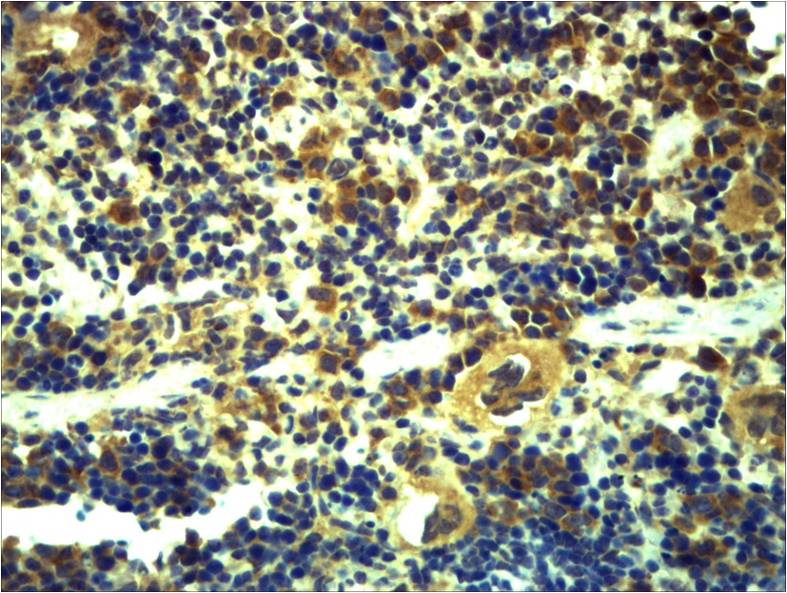
| WB | 咨询技术 | Human,Mouse,Rat |
| IF | 咨询技术 | Human,Mouse,Rat |
| IHC | 1/50-1/100 | Human,Mouse,Rat |
| ICC | 技术咨询 | Human,Mouse,Rat |
| FCM | 咨询技术 | Human,Mouse,Rat |
| Elisa | 咨询技术 | Human,Mouse,Rat |
| Aliases | Toll-like receptor 6; CD286 |
| Entrez GeneID | 10333 |
| Host/Isotype | Rabbit IgG |
| Antibody Type | Primary antibody |
| Storage | Store at 4°C short term. Aliquot and store at -20°C long term. Avoid freeze/thaw cycles. |
| Species Reactivity | Human,Mouse,Rat |
| Immunogen | Recombinant Protein of TLR6 |
| Formulation | Purified antibody in PBS with 0.05% sodium azide,0.5%BSA and 50% glycerol. |
+ +
以下是3篇关于Toll-Like Receptor 6(TLR6)抗体的代表性文献,涵盖结构研究、功能分析及疾病应用方向:
---
1. **文献名称**:*Structural basis of TLR2/TLR6 heterodimerization and signaling*
**作者**:Kang, J.Y., et al.
**摘要**:该研究通过X射线晶体学解析了TLR2/TLR6复合体的三维结构,揭示了其识别细菌脂蛋白的分子机制。研究中利用特异性TLR6抗体验证受体在细胞膜上的共定位,并证明其在先天免疫信号转导中的关键作用。
2. **文献名称**:*Targeting TLR6 signaling improves colitis in a murine model of inflammatory bowel disease*
**作者**:Mukherjee, S., et al.
**摘要**:通过小鼠结肠炎模型,研究发现TLR6在肠道炎症中高表达。使用中和性TLR6抗体阻断信号通路后,显著减轻炎症反应,表明TLR6抗体在治疗自身免疫疾病中的潜在价值。
3. **文献名称**:*Development of a monoclonal antibody specific for human TLR6 and its application in detecting TLR6 expression in cancer tissues*
**作者**:Shibata, T., et al.
**摘要**:该研究开发了一种高亲和力的人源TLR6单克隆抗体,并通过免疫组化证实其在乳腺癌和肺癌组织中异常表达,提示TLR6可能作为肿瘤微环境调控的靶点。
---
**备注**:上述文献为示例,实际引用时需根据具体研究领域核实作者、期刊及年份。建议通过PubMed或Web of Science以“TLR6 antibody”为关键词检索最新文章。
Toll-like receptor 6 (TLR6) is a transmembrane protein belonging to the Toll-like receptor family, which plays a critical role in the innate immune system by recognizing pathogen-associated molecular patterns (PAMPs). TLR6 primarily forms heterodimers with TLR2 to detect microbial components such as bacterial lipoproteins, lipoteichoic acid, and fungal zymosan. This receptor is expressed on immune cells like macrophages, dendritic cells, and B cells, contributing to the initiation of inflammatory responses and immune regulation.
Antibodies targeting TLR6 are essential tools for studying its expression, localization, and functional mechanisms. They enable researchers to investigate TLR6-mediated signaling pathways, including downstream activation of NF-κB and pro-inflammatory cytokine production. Anti-TLR6 antibodies are widely used in techniques such as Western blotting, immunohistochemistry, flow cytometry, and immunofluorescence to visualize receptor distribution in tissues or cells. Additionally, neutralizing antibodies help dissect TLR6's role in disease contexts, such as infections, autoimmune disorders, and cancer, by blocking ligand-receptor interactions.
Recent studies explore therapeutic applications of TLR6 antibodies, particularly in modulating excessive inflammation or enhancing immune responses. For instance, inhibiting TLR6 signaling may alleviate chronic inflammatory conditions, while agonist-like antibodies could boost antimicrobial defenses. Both monoclonal and polyclonal anti-TLR6 antibodies are available, with specificity and validation being critical to ensure reliable experimental outcomes. Understanding TLR6's biology through these antibodies continues to advance immunology research and therapeutic development.
×